Press release 2018-07-18 at 16:05

Blue-green algae conditions from satellite image, 16 July 2018: Due to the calm weather and wind conditions, blue-green algae has accumulated and compacted particularly in Finland’s coastal waters. There are also algae rafts in the open sea throughout the western and central parts of the Gulf of Finland. Source: ESA Copernicus Sentinel Data, 16 July 2018, processing by SYKE
In recent days, the Gulf of Finland and parts of the Archipelago Sea have seen exceptionally broad blooming of blue-green algae. According to the weather forecast, the exceptionally warm weather will continue for the whole week and the vigorous blue-green algae blooming is expected to continue in the coming days, particularly in southern marine areas. Lake areas have also seen large amounts of blue-green algae blooms.
Risks presented in algae forecast have been realised
At the beginning of June, the Finnish Environment Institute (SYKE) published an algae forecast for marine areas in which it was predicted that the majority of the Gulf of Finland faced a considerable risk of blue-green algae blooms. This forecast has now come true, but on an even broader scale than predicted. The calm and hot period of weather has boosted the formation of blue-green algae rafts.
‘The blooms do not primarily result from the phosphorus emissions in the Gulf of Finland’s own catchment area, as these have decreased during the past millennium more than anywhere else in the Baltic Sea area. Instead, it is the anoxic and very phosphorus-rich deep waters of the Baltic Sea’s main basin that are now affecting the situation in the whole Gulf of Finland area. The situation also partly results from the saline water inflows that came into the Baltic Sea between 2014 and 2016, which have pushed the old saline and phosphorus-rich deep waters of the main basin into the Gulf of Finland’, explains the SYKE Senior Research Scientist Seppo Knuuttila.
Global warming slows down Baltic Sea recovery
The nutrient load in the Baltic Sea still exceeds the updated goals set by the Baltic Marine Environment Protection Commission (HELCOM) in their 2013 Ministerial Meeting, although since the 1980s the phosphorus load has decreased by 60% and the nitrogen load by 40%, primarily thanks to wastewater treatment. The recovery from decades of excessive nutrient load is slowed down primarily by the anoxic and very phosphorus-rich water mass of the deep basins. According to the Swedish Meteorological and Hydrological Institute (SMHI), the volume of this water mass increased in Autumn 2017 to its current record level. The volume of the anoxic water mass in the world’s marine areas has increased fourfold since 1950, according to an article published in January 2018 in the scientific journal Science. The primary causes are global warming and anthropogenic nutrient loading.
‘In addition, warming in the Baltic Sea area will increase the risk of blue-green algae blooms in the future. The strengthening stratification of the water mass could cause the expansion of anoxic areas, which would in turn accelerate the release of phosphorus from the sea floor. Also, the increasingly common winter rain showers wash more nutrients into the sea from the catchment area.
Each person can influence their own Baltic Sea footprint
Getting the Baltic Sea into a good condition requires both the curbing of global warming and, in particular, a significant reduction in the emissions from the largest source of nutrient load: food production. 60% of the Baltic Sea footprint of the average Finn comes from food production. At the moment about 70% of all cultivated land in Finland is used for the production of animal-based food. The most effective way to reduce one’s own Baltic Sea footprint is to reduce meat consumption and replace it with organic fish sourced from the Baltic Sea. In addition, the best way to reduce one’s carbon footprint – which represents the amount of global-warming-causing greenhouse gases you produce – is to reduce your use of energy produced with fossil fuels, both in transport and at home, and to reduce in general your level of consumption.
‘Emissions from food production and climate change are both clearly connected with eutrophication. Both consumers’ choices and political actions throughout society have a significant impact on future eutrophication levels. Finland will hold the chairmanship of HELCOM for the next two years, so we now have a good opportunity to promote the reduction of emissions in all Baltic Sea countries’, Seppo Knuuttila believes.
20 years of algae monitoring and reports
The Finnish Environment Institute has provided weekly updates on algae conditions during the summer for over 20 years. The monitoring and reports initiated in 1997 after a particularly bad summer of algae. The blue-green algae blooming this summer is the largest in the Gulf of Finland this decade. The Finnish Environment Institute will step up its reporting on algae conditions for as long as the current serious situation continues. Information about algae is provided through the updates, the nationwide algae overview every Thursday, and in the social media. Citizens’ observations are important for monitoring algae conditions: these observations can be submitted to the Järvi-meriwiki (Lake and Sea Wiki).
Links
National algae bloom information
Baltic Sea calculator
-
Baltic Sea Calculator
With the calculator a consumer can assess the impact of their consumption habits on the nutrient loads of the Baltic Sea, that is, their own Baltic Sea footprint.
Images
Further information:
Baltic Sea conditions and nutrient load:
Senior Research Scientist Seppo Knuuttila, Finnish Environment Institute SYKE, Tel. +358 295 251 516, firstname.lastname@ymparisto.fi
Current blue-green algae conditions:
Sea areas: Researcher Sirpa Lehtinen, Finnish Environment Institute SYKE, Tel. +358 295 251 353, firstname.lastname@ymparisto.fi
Lakes: Limnologist Sari Mitikka, Finnish Environment Institute SYKE, Tel. +358 295 251 430, firstname.lastname@ymparisto.fi
Communications
Communications Chief Sirpa Pellinen, Finnish Environment Institute SYKE, Tel. +358 295 251 502, firstname.lastname@ymparisto.fi